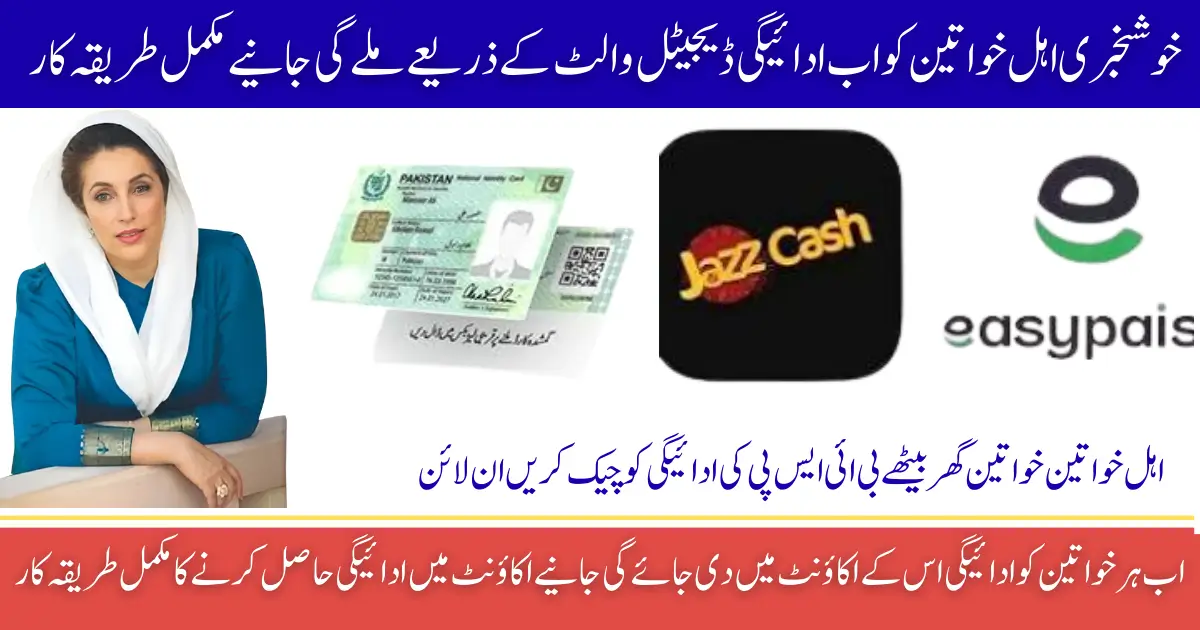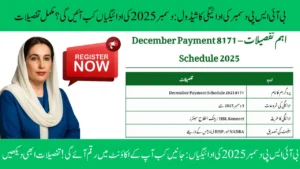BISP 8171 Digital Payment System
The BISP 8171 Digital Payment System enables eligible families in Pakistan to receive financial support quickly and securely through digital means. In the past, beneficiaries had to wait in line for a long time to receive cash, but now they can check their payment status online and receive funds electronically through digital wallet systems such as Easypaisa and JazzCash. Utilizing the ease of the BISP 8171 helps beneficiaries save time, travel costs, and access funding more quickly. The digital payment system is much more efficient compared to previously having to wait in long lines for cash!

Digital Payments under the BISP 8171 system provide transparency and are user-friendly. First, a beneficiary must have a valid CNIC and a registered wallet to receive the funds. The process is fully secured along with a fully digital payment method that is constantly operating 24/7. Users can track their payments easily and withdraw with no issues using the digital method.
You Can Also Read: BISP 8171 Result Check by CNIC, No Pre-Registration Needed
Check Your BISP 8171 Payment Status Online
You can check your BISP 8171 payment status online through the official web portal quickly, simply and at any time of the day. It is easy to use, very quick and you have 24/7 access. You only need a CNIC and a solid internet connection. This online option saves you time and effort and provides a status report in real time.
- To check your BISP 8171 payment status online, follow these steps:
- Go to the official 8171 web portal
- Provide your valid 13-digit CNIC number without dashes
- Click on the “Submit” button
- The status of your payment will be displayed on the screen
- Ensure that your CNIC is updated in the NSER database
The online method of checking BISP 8171 status is quick, easy and helps keep you informed as you wait for payments
You Can Also Read: BISP 8171 CNIC Check Online, September 2025 Welfare Payment Update
Advantages of Receiving BISP Payments Using Digital Wallets
By receiving BISP payments using digital wallets like Easypaisa and JazzCash, the time and hassle of getting the payment is minimized, while also increasing safety and convenience. Beneficiaries do not need to go to a payment center or sit in long lines anymore. They can simply receive payment directly into their mobile wallet and then access their payment anytime and anyplace, using their mobile phone. This method also minimizes the risk of fraud, and also guarantees that the money is reaching to the right individual in a timely manner.
- You can receive payments directly to your mobile wallet.
- You don’t have to experience long queues or travel expense.
- You can receive payments anywhere and at anytime.
- You can utilize safe and discreet transactions.
- You can see your payment history to date, in the app.
Digital wallets provide fast, safe, and convenient access for BISP payments at any time, from anywhere.
You Can Also Read: Punjab Farmer Welfare Package 2025, Main Highlights, Positive Outcomes, and Online Signup
List of Approved Digital Wallets for BISP Payments
| Digital Wallet / Service | Provider | Features |
| Easypaisa | Telenor Microfinance Bank (Telenor) | Nationwide coverage, large agent network, app & USSD access, supports biometric setups |
| JazzCash | Jazz (Mobilink Microfinance Bank) | Biometric-enabled outlets, app access, extensive agent and ATM network |
| HBL Konnect | Habib Bank Limited (HBL) | Bank-backed wallet, biometric activation at branches, assigned by district |
| Pakistan Post Digital Wallet | Pakistan Post | Digital services via upgraded post offices with biometric verification |
Easypaisa, JazzCash, HBL Konnect, and Pakistan Post wallets offer secure and convenient options for receiving BISP 8171 payments. All require CNIC verification and biometric authentication to ensure safe and accurate fund delivery.
How to Link Your CNIC with a Digital Wallet
Linking your CNIC with a digital wallet is a key step to receive BISP 8171 payments safely and directly. This process ensures your identity is verified and funds are sent to the correct person. Most digital wallets like Easypaisa, JazzCash, and HBL Konnect offer an easy way to link your CNIC through their mobile apps or at biometric-enabled agents. Make sure your CNIC is valid and matches your mobile number.
- Download and open your preferred digital wallet app.
- Enter your mobile number and create an account.
- Provide your 13-digit CNIC number during registration.
- Visit a nearby biometric agent to verify your identity.
- Once verified, your wallet will be linked with your CNIC.
Link your CNIC with a wallet through app registration and biometric verification to receive BISP payments smoothly.
You Can Also Read: Punjab Farmer Welfare Package 2025, Main Highlights, Positive Outcomes, and Online Signup
How to Withdraw BISP Funds from Your Digital Wallet
Withdrawing BISP 8171 funds from your digital wallet is simple, fast, and secure. Once your CNIC is verified and payment is received, you can access the money using mobile wallet apps like Easypaisa, JazzCash, or HBL Konnect. You can choose to withdraw cash from agents, transfer to a bank account, or use the funds for mobile payments and utility bills. Make sure your wallet is active and has a matching CNIC.
- Open your digital wallet app Easypaisa, JazzCash, or others.
- Check your balance to confirm BISP payment is received.
- Visit a nearby biometric agent or ATM (if supported).
- Select the “Withdraw Cash” or “Transfer to Bank” option.
- Verify using your CNIC and thumbprint where required.
- Receive cash or complete your transfer.
Summary: You can easily withdraw BISP funds through your digital wallet app or biometric agents after verifying your CNIC.
Common Issues and How to Solve Them
Many users face common issues while checking or withdrawing BISP 8171 payments through digital wallets. Problems like incorrect CNIC entry, unverified mobile wallets, or biometric mismatches can delay the process. These issues are usually easy to fix if you follow the correct steps. Always double-check your CNIC, ensure your wallet is active, and keep your data updated with BISP or NSER.
- Enter your CNIC as a 13-digit number without dashes or spaces.
- Make sure your mobile wallet is registered and verified
- Visit a biometric agent if your fingerprint is not verified online.
- Update your CNIC or NSER data if it’s outdated or incorrect.
- Contact the official BISP helpline for unresolved technical issues.
Fix common BISP issues by verifying your CNIC, updating your data, and using a registered digital wallet.
You Can Also Read: CM Punjab Solar Scheme Result 2025 Announced, Instant Result Lookup
Security Tips for Using Digital Wallets
Using digital wallets for BISP payments is safe when you follow simple security measures. Protect your personal information and avoid sharing your CNIC or wallet PIN with anyone. Always use strong passwords and keep your mobile device secure. Be cautious when using public Wi-Fi and only download wallet apps from official sources to avoid fraud or hacking.
- Use a strong, unique password for your wallet app.
- Never share your CNIC number or PIN with others.
- Enable biometric authentication if available.
- Avoid using public Wi-Fi for transactions.
- Download apps only from official stores like Google Play or Apple Store.
Protect your BISP funds by using strong passwords, securing your device, and avoiding sharing sensitive information.
You Can Also Read: CM Punjab Himmat Card Phase 2 Launched, Determine Eligibility and Claim Your Spot
When to Recheck Your BISP 8171 Status
It’s important to regularly recheck your BISP 8171 status to stay updated on your eligibility and payment details. You should check your status after submitting any new documents or updates to your CNIC or NSER data. Also, recheck before payment cycles to ensure your information is accurate. Frequent checks help avoid missing payments and keep your records current.
- Recheck after updating your CNIC or NSER information.
- Check before each payment cycle or installment.
- Verify your status if you notice delays in payment.
- Revisit the portal if you suspect errors in your data.
- Check every 4 to 6 months for regular updates.
Summary: Regularly recheck your BISP 8171 status to ensure timely payments and updated information.
You Can Also Read: CM Punjab Himmat Card Phase 2 Launched, Determine Eligibility and Claim Your Spot
Final Thoughts Stay Updated and Use Secure Channels
Always use official and secure channels like the 8171 web portal or approved digital wallets to check your BISP 8171 status and receive payments. These platforms protect your personal data and provide accurate information quickly. Avoid unofficial websites or apps to keep your information safe from fraud. Staying updated with your CNIC details and eligibility status helps you receive timely financial support without any issues.
Make it a habit to verify your information regularly, especially after any changes to your CNIC or NSER records. Using trusted digital wallets and verified agents ensures smooth transactions and quick access to your funds. By staying informed and cautious, you can easily manage your benefits and protect your personal data at all times.
You Can Also Read: 8171 Web Portal CNIC Check Online, Verify Eligibility in Seconds
Common Questions
How can I check my BISP 8171 payment status?
You can check your payment status online through the official 8171 web portal by entering your 13-digit CNIC number without dashes.
Can I receive BISP payments through a digital wallet?
Yes, BISP payments can be received through approved digital wallets like Easypaisa, JazzCash, HBL Konnect, and Pakistan Post.
What should I do if my CNIC is not linked to my digital wallet?
Visit a biometric agent or use your wallet app to link your CNIC by verifying your identity with biometric authentication.
Is it safe to use digital wallets for BISP payments?
Yes, as long as you use official apps, keep your PIN and CNIC confidential, and enable biometric security, digital wallets are safe.
How often should I check my BISP 8171 status?
It is best to check your status before each payment cycle and after any updates to your CNIC or NSER data, typically every 4 to 6 months.









